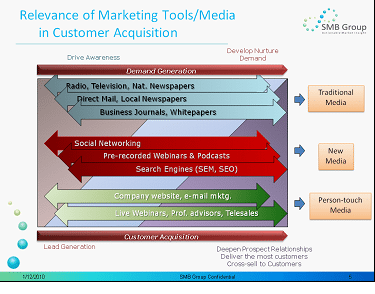The topic of lead generation and the role of various media solutions in the lead generation process draw significant conversation. From a survey of small businesses done in the summer of 2009 and detailed in my blog, ‘GoToMeeting‘ from CitrixOnline or ‘Intuit Website’ from Intuit. This form of media effectively cultivates and nurtures demand. ‘Small Businesses interest in Social Media Increasing ‘ and with regards to tools used by small businesses to promote their business (not generate sales leads), 77% of small businesses are using or plan to use social media tools. Why has the use of social media seen such a dramatic increase? This is primarily driven by several factors:
- Change in the personal communication environment and habits of consumers and business workers
- Low barriers to entry: the cost of participating in the social media communications are very low and some—tools like Twitter, Facebook, WordPress and LinkedIn—are even free
- Social media solutions are a one-to-many form of real-time communications
- Social media is much more than a digital form of viral marketing – it is an effective and inexpensive way to convert contacts into a referral network
Traditional Media tools. On one end of the spectrum, marketing is responsible for Demand Generation by driving awareness. Traditional media tools such as radio, television, newspapers and business journals (in their print form), provide broadcast opportunities and are good for creating broad awareness to develop interest among consumers and businesses – otherwise known as Outbound Marketing. Successful examples include the TV commercials like ‘GoToMeeting’ from CitrixOnline or ‘Intuit Website’ from Intuit. This form of media effectively cultivates and nurtures demand.
New Media/Digital Media include Social Networking tools (Facebook, Blogs, Twitter, LinkedIn, etc.), Webinars and Podcasts, and Search Engines. Such ‘inbound marketing’ tools enable businesses with product/service increase awareness already developed to a certain level through traditional tools to further draw in consumers and encourage their further investigation of the company’s product or service.
An SMB survey from Citibank found that some small businesses saw little reason to hop onto the social-network bandwagon. The majority of them found sites like Facebook, Twitter, and LinkedIn to be of little help in finding new business leads. While social media can certainly provide channels to network and help a growing business flourish, many SMBs do not have the manpower or the time required to take advantage of them—that is, use them to look for business advice or information. It is up to the business to bring in the relevant social media conversations related to crowd-sourced recommendations for their company and solutions into their company website or other discussion forums. Techniques that do this are illustrated very well in the “Inbound Marketing” book by founders of HubSpot.
Personal-touch Media tools like company website, e-mail marketing, live webinars, and professional advisors provide the information to convert exploring consumers and business buyers into potential leads. The new media-based inbound marketing solutions drive the explorers to the company website and/or additional personal touch based media and channels. However, SMBs must work to channel their company relevant social media discussions into their website. These social media conversations are similar to word-of-mouth and personal communication methods. Ultimately, these personal-touch media solutions are directly involved with actual lead generation, ongoing lead nurturing and finally conversion to customers as well as cross-selling and up-selling to existing customers continually deepening prospect relationships
Some of the new marketing automation and lead nurturing solution companies like Marketo, HubSpot and Demandbase are combining some of the key aspects of New Media/communications and Personal-touch Media/communications solutions that provide great value to the SMB and mid-market companies for both outbound and inbound marketing – and most of these solutions can be implemented for a fraction of the cost of a marketing person.

